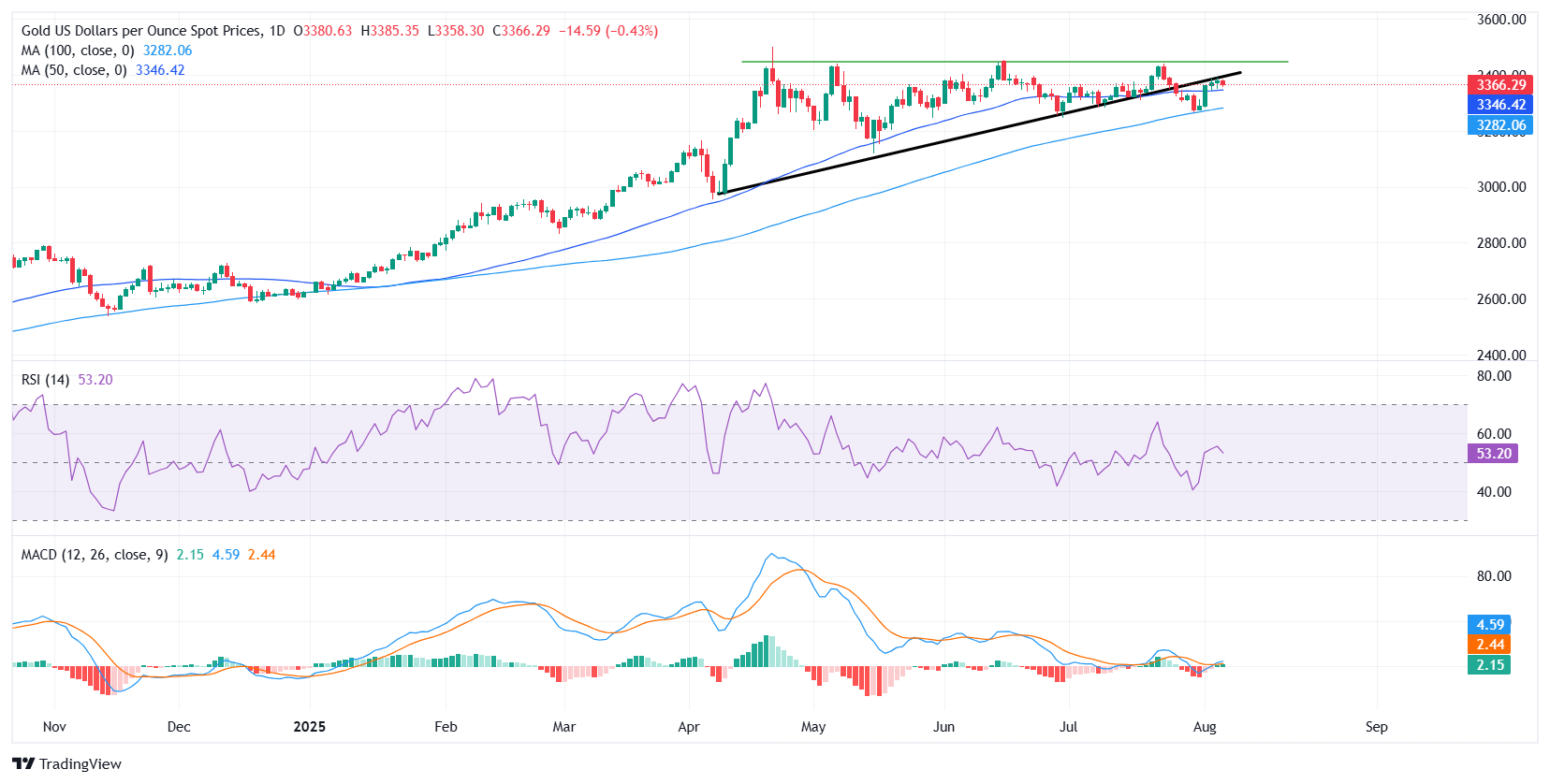Created
: 2025.08.06














![]() 2025.08.06 20:48
2025.08.06 20:48
Gold (XAU/USD) slips modestly on Wednesday, snapping a four-day winning streak as bulls struggle to extend gains beyond the key $3,400 psychological barrier.
The yellow metal marked a fresh two-week high near $3,391 on Tuesday but has since retreated, last seen trading around $3,366 during European trading hours. A broadly steady US Dollar and subdued Treasury yields are limiting further upside, as the Greenback is holding firm near the lower end of its range established following last week's Nonfarm Payrolls (NFP) report.
Traders remain on the sidelines, refraining from placing aggressive bets as the market reassesses the Federal Reserve's (Fed) monetary policy outlook. The latest batch of US economic data has cast doubts over the resilience of the world's largest economy, reinforcing uncertainty ahead of the September policy decision. Still, the downside in Gold appears limited amid persistent global tariff tensions and firm market expectations that the Fed will lower interest rates next month.
Cautious sentiment also lingers as attention turns to the political shake-up at the Federal Reserve. The resignation of Fed Governor Adriana Kugler, effective August 8, has created a key vacancy on the Board. US President Donald Trump is expected to name her replacement by the end of the week.
Speculation over the potential nominees is fueling concerns that the Fed may tilt toward a looser monetary policy stance, particularly as President Trump has repeatedly stated that, in his view, interest rates should be cut. The move comes at a sensitive time, with markets already pricing in a high probability of a rate cut in September. Any sign of political influence over the Fed could inject fresh volatility into financial markets and reinforce safe-haven demand for Gold.

Gold (XAU/USD) slips modestly on Wednesday, struggling to sustain momentum after stalling below the key $3,400 psychological barrier. The metal briefly broke below the ascending triangle's lower trendline last week and found support just above the 100-day Simple Moving Average (SMA) at $3,282.
While the spot prices have since rebounded, the recovery was capped as prices were rejected at the broken triangle support, which is now acting as resistance.
The metal continues to consolidate just above the 50-day SMA near $3,346, which acts as immediate support, followed by the 100-day SMA. If prices break lower, the next targets could be around $3,200 and $3,150.
Momentum indicators remain mixed, reflecting indecision. The Relative Strength Index (RSI) on the daily chart sits at 52, hovering in neutral territory, suggesting neither bulls nor bears are in clear control.
Meanwhile, the Moving Average Convergence Divergence (MACD) indicator is showing early signs of recovery, with a minor bullish crossover and flattening histogram, indicating that bearish pressure may be fading.
A decisive daily close above the $3,390-$3,400 resistance band would invalidate the triangle breakdown and open the door for a potential run toward $3,450, with all-time highs around $3,500 back on the radar.
Gold has played a key role in human's history as it has been widely used as a store of value and medium of exchange. Currently, apart from its shine and usage for jewelry, the precious metal is widely seen as a safe-haven asset, meaning that it is considered a good investment during turbulent times. Gold is also widely seen as a hedge against inflation and against depreciating currencies as it doesn't rely on any specific issuer or government.
Central banks are the biggest Gold holders. In their aim to support their currencies in turbulent times, central banks tend to diversify their reserves and buy Gold to improve the perceived strength of the economy and the currency. High Gold reserves can be a source of trust for a country's solvency. Central banks added 1,136 tonnes of Gold worth around $70 billion to their reserves in 2022, according to data from the World Gold Council. This is the highest yearly purchase since records began. Central banks from emerging economies such as China, India and Turkey are quickly increasing their Gold reserves.
Gold has an inverse correlation with the US Dollar and US Treasuries, which are both major reserve and safe-haven assets. When the Dollar depreciates, Gold tends to rise, enabling investors and central banks to diversify their assets in turbulent times. Gold is also inversely correlated with risk assets. A rally in the stock market tends to weaken Gold price, while sell-offs in riskier markets tend to favor the precious metal.
The price can move due to a wide range of factors. Geopolitical instability or fears of a deep recession can quickly make Gold price escalate due to its safe-haven status. As a yield-less asset, Gold tends to rise with lower interest rates, while higher cost of money usually weighs down on the yellow metal. Still, most moves depend on how the US Dollar (USD) behaves as the asset is priced in dollars (XAU/USD). A strong Dollar tends to keep the price of Gold controlled, whereas a weaker Dollar is likely to push Gold prices up.
![]()
Created
: 2025.08.06
![]()
Last updated
: 2025.08.06

FXStreet is a forex information website, delivering market analysis and news articles 24/7.
It features a number of articles contributed by well-known analysts, in addition to the ones by its editorial team.
Founded in 2000 by Francesc Riverola, a Spanish economist, it has grown to become a world-renowned information website.
We hope you find this article useful. Any comments or suggestions will be greatly appreciated.
We are also looking for writers with extensive experience in forex and crypto to join us.
please contact us at [email protected].
Disclaimer:
All information and content provided on this website is provided for informational purposes only and is not intended to solicit any investment. Although all efforts are made in order to ensure that the information is correct, no guarantee is provided for the accuracy of any content on this website. Any decision made shall be the responsibility of the investor and Myforex does not take any responsibility whatsoever regarding the use of any information provided herein.
The content provided on this website belongs to Myforex and, where stated, the relevant licensors. All rights are reserved by Myforex and the relevant licensors, and no content of this website, whether in full or in part, shall be copied or displayed elsewhere without the explicit written permission of the relevant copyright holder. If you wish to use any part of the content provided on this website, please ensure that you contact Myforex.
Myforex uses cookies to improve the convenience and functionality of this website. This website may include cookies not only by us but also by third parties (advertisers, log analysts, etc.) for the purpose of tracking the activities of users. Cookie policy